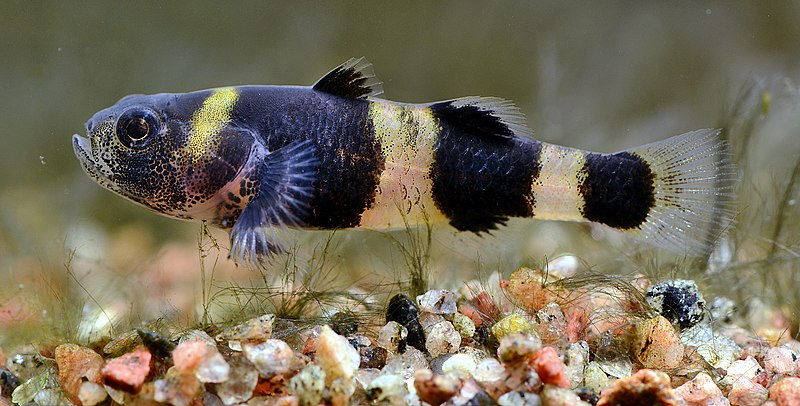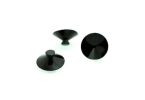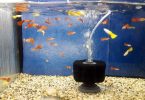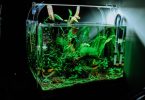Table of Contents
In this complete care guide to bumblebee catfish keeping, we will be giving a properly detailed breakdown of everything you will need to learn and know to be able to excel in keeping a bumblebee catfish.
You will learn the background, natural habitat, size, compatible tank mates and feeding behavior of bumblebee catfish, among other things.
Aquarium keepers are always looking for vibrant colored fishes to brighten up their tank and add ambience to their tanks.
Fishkeeping is about creating a beautiful and interesting tank that is occupied by equally interesting looking fishes.
Sometimes, fish keepers do not mind the hours of hard work and precision parameters required in getting their tanks in tip top shape for the optimal health of their fishes, provided thy get to sit back and bask in the amazement of their creature which, no doubt, would fill anyone with a deeply satisfying sense of fulfilment, not to talk of an aquarist.
Fish keepers, especially beginners, may make the mistake of thinking that brightly colored decorations are what makes a fish tank get it’s relaxing feel.
This, however, is not the case, as it is always better to recreate the natural habitat of the fishes in your tank.
So, rather than focusing on the decorations of a tank, it is always better to choose fishes that are easy to keep but also, at the same time, have amazingly beautiful colors that play against the sometimes dull waters of their natural habitat.
This means that, as a fish keeper, experienced or novice, you have to pick a fish that is unique in its appearance.
However, especially for beginners into the fishkeeping hobby, it is important to know that in choosing fishes that would afford one a beautiful tank, it is highly imperative to keep the water requirements of the fishes in mind as some tend to be more stringent and require utmost care and attention than others.
The marine (saltwater) system fishkeeping tanks, for instance are very distinct because the system has numerous gorgeous fishes that stand out in the most amazing ways but marine tanks are pricey to set up and so are the species of fishes to be kept in the tank.
Also, a marine tank is difficult to maintain due to the tight control one needs to have on the water conditions to ensure that the fishes continue to enjoy complete health.
Therefore, as a beginner fish keeper, who might not have the inclination to put up with learning everything there is to know about keeping saltwater fish species.
A freshwater fish tank is the best bet for you because not only is it easier to set up and maintain, the fishes themselves are relatively cheap and you can rest assured that you can still create a beautiful tank that houses equally as beautiful and low maintenance freshwater fish species including but not limited to discus, male electric blue harp, fancy guppies, neon tetras, broseman’s rainbow fishes, german blue rams, killifishes, dwarf gouramis, rosy barbs, swordtail, cherry barbs, harlequin rasboras, zebra danios, mollies, tiger barbs, platies, golden plecos, endler’s livebearers, betta fishes and, of course, Bumblebee Catfish.
These fishes are freshwater fishes that would normally get along in a community setting, are hardy and are easy to care for, which is great for beginners.
The bumblebee catfish is a beautiful, shy and fun to watch freshwater fish species that has been making the rounds in recent times.
It’s beautiful look, easygoing temperance and care requirements, coupled with it’s hardiness, leaves no questions as to why it is a fast growing favorite among fishkeepers in the aquarium world.
They are perfect for experienced fish keepers who are just looking to add color to their tanks and also for beginners who want a fish tank that is not only easy to keep but, also, beautiful.
Bumblebee Catfish: what you need to know
Name and Origin
There are more than a species of bumblebee catfish as the name refers to all the members of the Pseudo Pimelodidae family in the microglanis genus and this includes about forty pecies.
For the purposes of this article, we are talking specifically about the Bumblebee Catfish scientifically known as Microglanis Iheringe which though often confused with the Asian bumblebee catfish is the most commonly kept bumblebee catfish in home freshwater aquarium tanks.
This species (microglanis iheringi) originated from the South American continent. It is found in freshwater rivers and streams of Colombia, Brazil, Guyana and Ecuador. Bumblebee Catfish was first documented in the early nineteen century.
Appearance
It would be pretty disappointing for it to be named after a bumblebee without the corresponding appearance of a bumblebee, wouldn’t it?
So, yes, you guessed right, just from reading it’s name. This very beautiful fish has thick colorful bands of black and yellow alternating from it’s head to its tail in a similar fashion of a traditional bumblebee.
The outer layer of the body is not scales as is typical of fishes but skin, in a true catfish fashion.
Also, like other catfishes, their bodies are cylindrical albeit slightly flattened especially before the caudal fin with a mouth that stretches open to allow them to eat large food items.
Another distinctive feature of the fish would be it’s fins, they are big and spot another black design.
The dorsal fins have well developed spines that allow it to stand well and the caudal fin comes after on the remaining parts of the fish with a forked shape and similar bands of color in thickness with a typically back base.
Another unique feature of all catfishes is their whisker-like barbels which are used for getting a feel for their environment as well as for tasting and smelling too. In bumblebee catfish, their barbels are long and can reach back to the pectoral fins.
It also has a pretty large splayed ventral fin that helps them navigate the substrate and is especially important as the bumblebee catfish is a bottom feeder. Their heads are also usually black and flattened with well-marked lateral lines.
Size
The bumblebee catfish once fully grown can reach upto three to four inches in length. It is a little fish that does not take up a lot of space at the bottom of the tank.
This tank can vary a little based on the environment they were in before it was gotten by the keeper and the quality of care they are provided with as they continue to grow. Regardless of the care anyways, they rarely get bigger than 4 inches.
Lifespan
A typical bumblebee catfish has an average lifespan of about 4 – 5 years. You should note that it is not out of place for them to exceed the 5 year mark, though that feat is only made possible by the kind of attentive care they get throughout their entire life.
Natural habitat
They are often found in freshwater habitats in tropical south america especially those with fast flowing water currents.
The fast flow of currents helps to keep their environment cream and oxygenated. They are also bottom dwellers who particularly like hiding among the rocks, caves, driftwoods, plants and debris sitting on a sandy substrate.
Their waters are tropical and warm with a fairly neutral pH level. So, to keep the fishes healthy, happy and to max out their lifespan, these conditions would have to be recreated.
Temperance and behavior
The first important factor on behalf of a bumblebee catfish is that they are nocturnal in nature, mostly active at night or when the lights in the aquarium are off. So, do not be alarmed when you do not see many of them during the day.
They are very peaceful and occupy mostly the middle and base regions of the tank. Very rarely swim out in open waters to find food (especially if they’re hungry) and then promptly hide themselves back in their caves and hiding places.
They are a very shy species and need peaceful tank mates to prevent them from being stressed.
Care for bumblebee catfish.
Tank set up
The fishes might not take up a lot of space owing to size but they do require enough space to swim around in their occasional search for food.
So, endeavor to provide as much space as you can get away with. A minimum of a 20 gallon tank is very much suitable for adult bumblebee catfish.
To keep a few together, you should seek to add extra 10 gallons for each additional bumblebee catfish. And provide extra hiding places for each to prevent aggression towards each other.
Tank conditions and water parameters
In setting up an optimal tank, the bottom of the tank should be filled and layered with a soft sandy substrate.
With the absence of scales on their body, they are highly susceptible to being scratched by sharp gravel and as the bottom of the tank is where the larger bulk of their time is spent, it is very important that the substrates be paid special attention so as to minimize their susceptibility to injuries.
The substrates should be followed by cave crevices which makes for a hiding place for the fish. Rocks and driftwoods can be used to achieve this.
As the fish is nocturnal and prefers hiding most of the time, the base of the tank is especially important to them to prevent being stressed which would affect the quality of their lives.
If you worry about being unable to see the fish as much as you would like, you should remember that they would swim out to find food to eat.
The possibility of sighting them, especially during the day, can be helped along by making sure to strategically place the rock and driftwoods in visible areas that are within your line of sight.
Placing driftwood alongside the glass of the tank is also advised as it gives you the opportunity to see their tunnels especially from outside.
The plants that are most suitable for bumblebee catfish tanks include java ferns, anubias and amazon swordfish as they are compatible with providing adequate cover and protection for the fish.
Standard aquarium lighting is adequate for the tank of a bumblebee catfish as they tend to hide away when the lights are turned on anyways due to their extremely shy nature.
Water conditions
As previously mentioned, the bumblebee catfish is native to the tropical waters of South America. These waters are typically warm with a neutral pH.
So, in recreating this, the temperature of between 70 degrees fahrenheit and 78 degree fahrenheit is highly advised.
This can be made consistent by the use of a water heater to keep it within range. The pH level should be between 6.5 and 7.5. Note that a slightly acidic environment would be highly appreciated by the fishes.
The water should be soft and between 8 – 12 dGH and a good water filter is recommended also. An air pump could also be used to help with flow and oxygenate water. Tank should be regularly cleaned with water changes and testing performed every week.
Ideal tank mates.
Bumblebee Catfish keep to themselves and due to their shy nature they spend a lot of their time hiding away.
This makes them compatible with a wide range of other species. There are a few things to consider however.
First is that the bumblebee catfish can be easily stressed out by active fishes which can in turn have them hiding away and missing meals which would have adverse effects on their health.
So, very peaceful and calm fishes would be more considerate to them. Second is the possibility of a bumblebee catfish to eat fishes that can fit into their mouths (remember they have a wide mouth that stretches open to eat large meals) so, nano fishes that are less than 1.5 inches in length would be at risk of being eaten and should be avoided.
The following fishes are therefore considered good options for the tank of a bumblebee catfish: tiger barbs, rainbow sharks, gouramis, emperor tetras, yoyo loaches, eels, iridescent sharks, plecos and other catfish.
Simply put, as long as they are not super aggressive or extremely small, the fishes are going to be okay living with bumblebee catfish.
Diet and feeding
These fish species are omnivores. Though they lean more to being carnivores than they do to being omnivores.
Anyway, this makes them very easy to feed as they eat live foods as well as plant matter which exponentially increases their range of food and is important for a very healthy diet.
Live foods like larvae, daphnia, bloodworms, earthworms, brine shrimps, prawns, beef heart mussels and insects are preferable as they are more nutritious and satisfying for their diet.
Sinking pellets, flakes and algae wafers also work well, especially if the fish is in a community tank, as these would be more likely to reach the bumblebee catfish.
Another option that can be considered is high quality fried foods as they are really cheap, convenient and readily available in all let stores.
They have less nutritional value though because of the manufacturing process they are subjected to and should be used on a supplementary basis. Over feeding should be avoided.
Note that the fish would not eat living plant matter. So, when they do come out to search for food, when they are hungry, all they eat from the surface is dead plant matter.
They could however be fed with cut up green vegetables. These vegetables can also be used to make homemade fish foods.
Opt to feed them at night as that is the time they are more active and likely to come out of their hiding places. They can be fed small amounts for up to three to five times a day.
Finally, it is important to remove any uneaten food to prevent decay which pollutes the water and puts the fishes at risk of being infected.
Breeding.
Breeding of this species of fish in a home tank is not known to be successful as of yet, so it is highly advised against.
It is mostly done in dedicated fish farms. The impracticality of breeding bumblebee catfish is largely due to the impossibility of telling a female bumblebee catfish apart from a male bumblebee catfish as they look extremely similar.
The females are known to look slightly plumper from above but this is only true when they are carrying eggs.
Breeding generally takes the form of the female bumblebee catfish spawning with the male and laying her fertilized eggs in a safe space after which it becomes the male’s job to look after them and fend off predators.
The eggs hatch in three to four days and can be fed using shrimp brine or other specialized liquid foods.
Health issues.
This fish is extremely hardy and survives in a wide array of conditions. They are not prone to specific diseases except those that would generally affect all fishes. This can be avoided by adding iodine solution to the tank.
Conclusion
This species of fish is great, they use their ability to vacuum organic matter to clean up after themselves and even though they play a little hard to get, eventually catching a glimpse of their amazing colors when they come out to eat can be very satisfying.







